AI platforms like ChatGPT, Google Gemini, Perplexity, and Grok have become go-to tools for users seeking recommendations, such as “top 10 digital marketing companies in Toronto.” Unlike traditional search engines, these AIs don’t just rank web pages—they synthesize information into concise, natural-language responses, often highlighting a shortlist of brands. This process can make or break a business’s visibility, as being mentioned in an AI’s “top list” drives traffic and credibility.
Below, I break down the process step by step, diving into the algorithms and strategies to optimize for AI-driven brand mentions. This expands on the two-step process of data retrieval and filtering, with detailed insights into BM25, TF-IDF, and dense retrieval.
Step 1: Gathering Data via Live Search APIs and Tools
AI platforms rarely rely solely on pre-trained knowledge, especially for dynamic queries like brand recommendations. Instead, they query external sources in real-time to ensure freshness and accuracy.
-
Live Search Integration: Most AIs tap into search engines or APIs, pulling data from search indices, news, directories, or review platforms. For instance, some use Bing or Google APIs, while others employ custom crawlers or social media searches for real-time insights.
-
Data Sources: The initial pool includes websites, news articles, directories (e.g., Clutch, Yelp), review sites (e.g., Google Reviews, Trustpilot), blogs, Wikipedia, and social media. AIs prioritize credible, recent content—recency is key, as older data may be downweighted.
-
Query Interpretation: Before searching, the AI uses its language model to understand intent. For “top 10 digital marketing companies in Toronto,” it might expand to synonyms like “best agencies” or “leading firms” and incorporate location-based personalization.
This step creates a broad candidate list—potentially hundreds of brands—based on what’s visible online.
Step 2: Filtering and Ranking Through Retrieval Systems
Once data is gathered, AIs apply sophisticated retrieval and ranking to distill it into a shortlist (typically 5–10 items). This is a hybrid of sparse and dense retrieval techniques.
Sparse Retrieval (Keyword-Based Scoring)
This fast, initial filter focuses on exact or near-exact matches, similar to classic search engines.
-
BM25 (Best Match 25): A probabilistic ranking algorithm that scores documents based on term frequency (how often keywords appear), inverse document frequency (rarity across the corpus), and normalization for document length. For example, if your site’s title includes “Top Digital Marketing Agency in Toronto,” it gets a high BM25 score for that query.
-
TF-IDF (Term Frequency–Inverse Document Frequency): A foundational metric that boosts unique keywords. If “Toronto digital marketing” appears frequently on your page but rarely elsewhere, it signals relevance. This is often applied to meta titles, descriptions, URLs, and snippets.
-
Heuristics and Modifiers: AIs give extra weight to confidence-boosting words like “best,” “top,” “leading,” or “trusted.” Position matters too—keywords in titles or H1 tags score higher than in body text.
Sparse retrieval quickly narrows the pool by matching the query to snippets from search results.
Dense Retrieval (Semantic Search)
This handles contextual understanding, going beyond keywords to capture meaning.
-
Vector Embeddings: Content is converted into high-dimensional vectors using models like BERT. Similarity is measured via cosine distance or dot products—e.g., “leading agency” might score close to “top company” even without exact matches.
-
Neural Relevance Models: These understand nuances like synonyms (“maintenance” ≈ “support services”) or intent (“near me” implies local relevance). This refines lists based on trends and user context.
Hybrid Retrieval
Most AIs combine sparse and dense methods for balanced results:
-
Scoring Fusion: A weighted sum or ensemble model merges BM25/TF-IDF scores with semantic similarities. For brand shortlists, this favors snippets that are both keyword-rich and contextually aligned.
-
Post-Filtering: Additional layers check for credibility (e.g., authority from backlinks), diversity (avoiding duplicates), and sentiment (positive reviews boost rankings). The output is a ranked shortlist embedded in natural language.
Google vs. AI Platforms: A Deeper Comparison
Here’s an expanded comparison of Google and AI platforms:
|
Aspect |
Google Search |
AI Platforms |
|---|---|---|
|
Data Source |
A vast web index via constant crawling |
Live APIs + pre-trained knowledge + specialized tools |
|
Ranking Method |
PageRank (backlinks, authority) + BM25/TF-IDF + neural models (RankBrain) |
Hybrid retrieval: Sparse (BM25/TF-IDF) + dense (embeddings) + heuristics |
|
Result Format |
SERPs with 10+ links per page, snippets, and featured answers |
Synthesized lists (5–10 items) with explanations |
|
Personalization |
Based on location, history, device, increasingly AI-driven |
Query context, interpreted intent; some use user history |
|
Update Frequency |
Real-time indexing with periodic updates |
Real-time API calls + periodic model fine-tuning |
|
Bias Handling |
Algorithms aim for neutrality but are influenced by web biases |
Emphasizes diverse perspectives; filters for credibility |
Google provides raw access, while AIs curate—like a summarizer selecting the “best” from the stack.
Let’s Try the Same Query on Different Platforms:
If you search “what are the best website maintenance companies in Toronto?” on different popular AI platforms, here is what you will see;
1- Google:
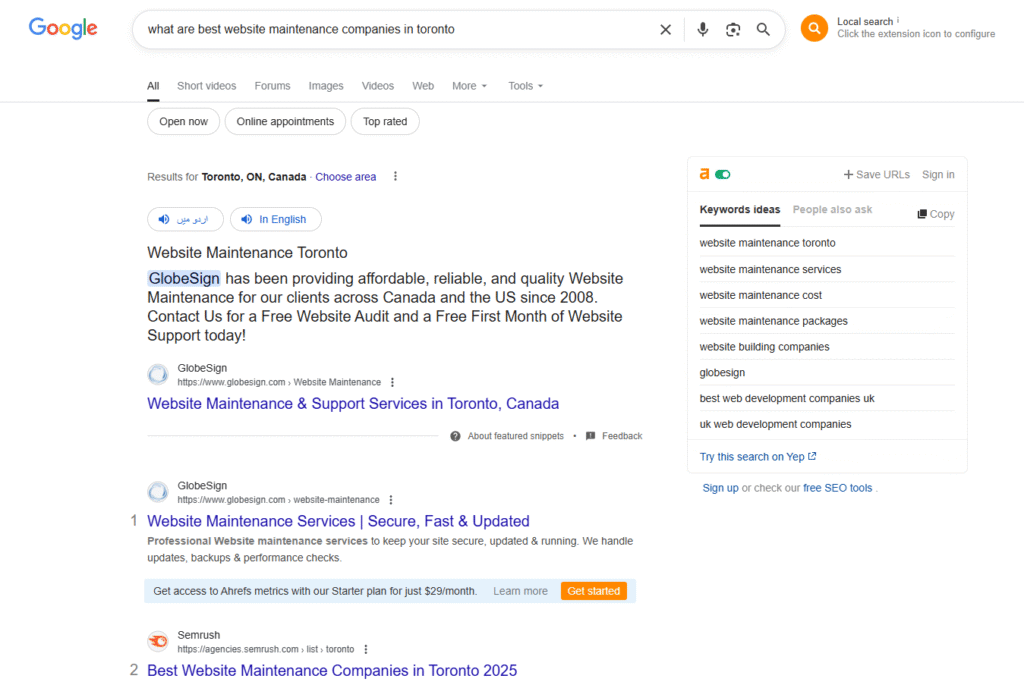
2- Bing:
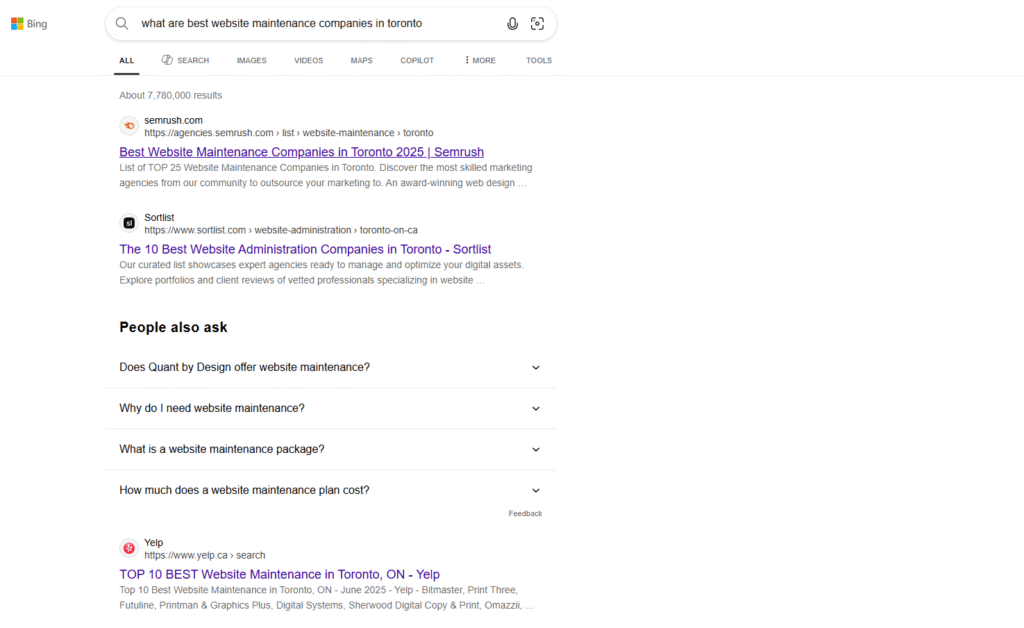
3- Chat GPT:
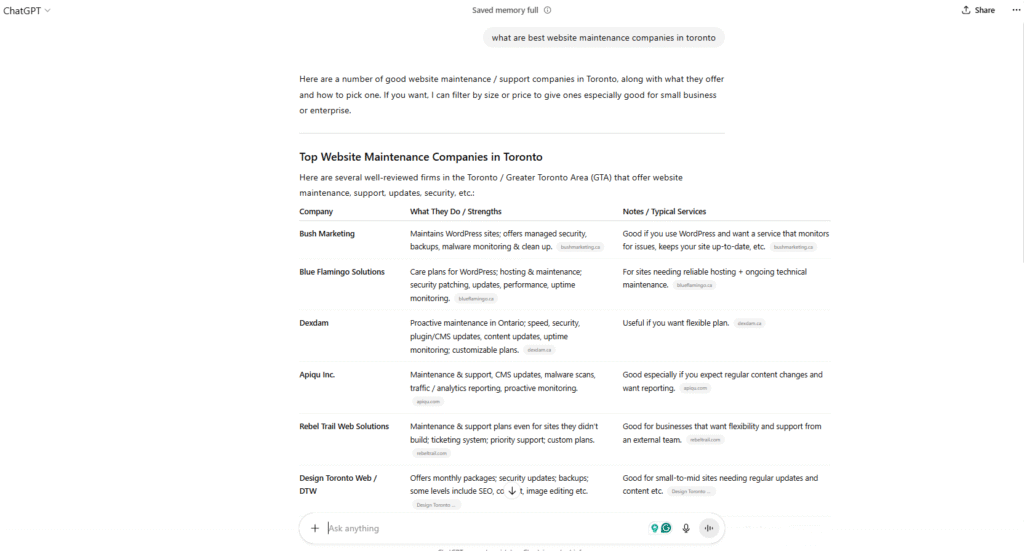
4- Grok:
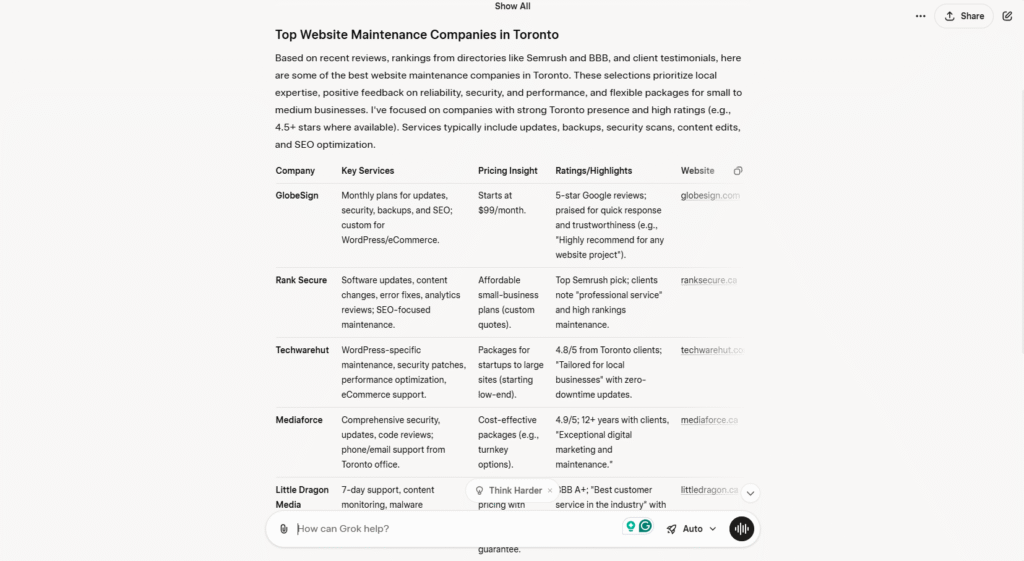
5- Preplixity:
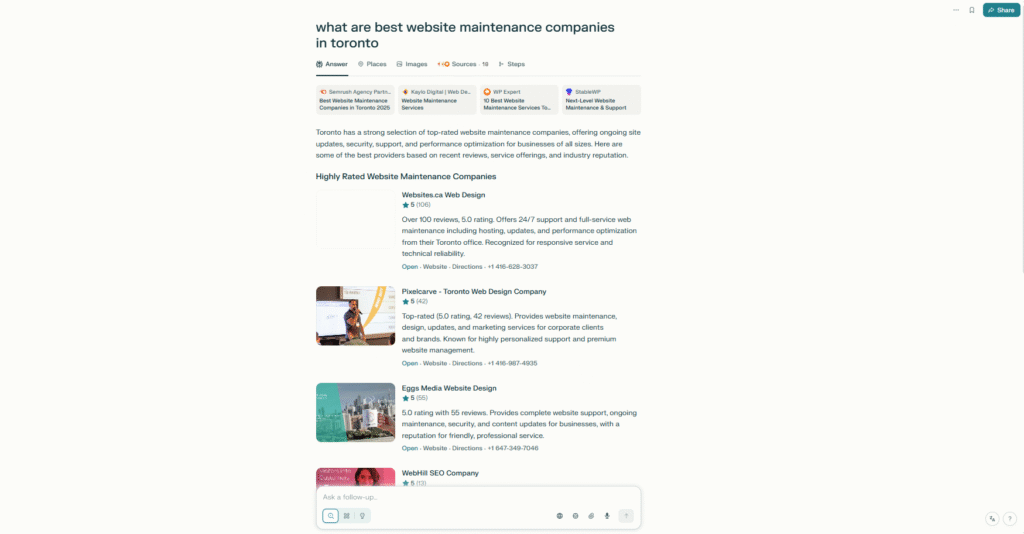
6- Gemini:
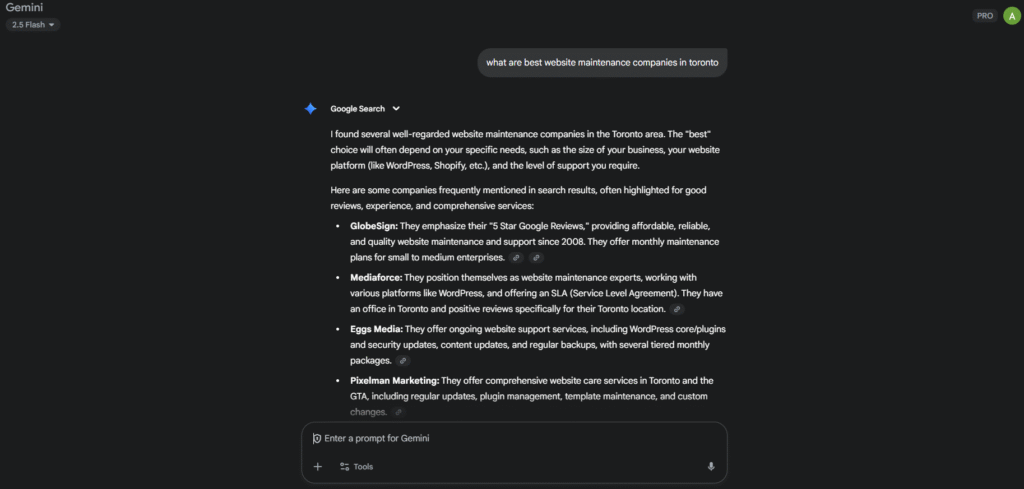
7- DeepSeek: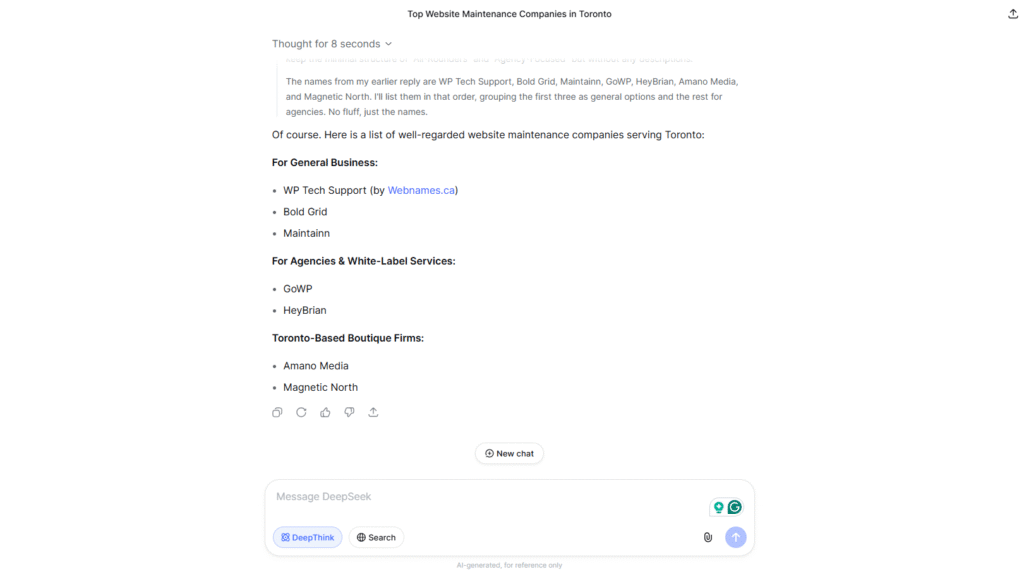
8- Meta AI:
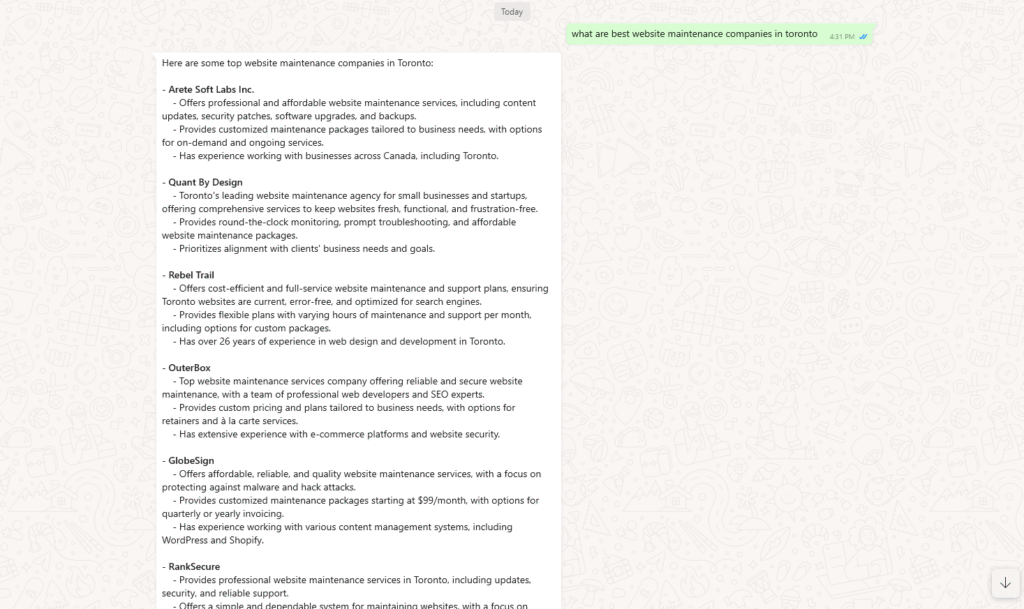
Why This Matters for Your Business
As AI adoption grows, missing out on mentions means lost opportunities. Businesses optimizing for AI can see boosts in referrals, especially for local or niche queries.
How to Get Shortlisted: Actionable Strategies
Here’s how to align with hybrid retrieval:
-
Optimize for Keywords and Semantics: Target exact phrases in titles/descriptions (for BM25) and synonyms (for dense retrieval). Use tools like SEMrush to identify variations.
-
Strengthen Meta Titles and Descriptions: Keep them under 60/160 characters, keyword-frontloaded, and modifier-rich (e.g., “Top-Rated Digital Marketing Agency in Toronto | [Brand]”). This impacts snippet strength in APIs.
-
Build Niche Authority Pages: Dedicated landing pages improve sparse matching. Include structured data (Schema.org) for better semantic understanding.
-
Amplify External Mentions: List on directories and earn backlinks/reviews. High-authority sites like Reddit or Clutch feed into AI sources. Encourage positive sentiment.
-
Use Trust-Building Language: Incorporate specifics (e.g., “Serving 500+ clients since 2010”) to boost heuristic scores. Avoid fluff—focus on verifiable claims.
-
Monitor and Adapt: Use tracking tools to query AIs regularly and adjust. Test variations like “best vs. top” to spot gaps.
Final Thoughts
AI retrieval is a new frontier in SEO, blending traditional algorithms with semantic intelligence. By focusing on hybrid scoring—keyword precision via BM25/TF-IDF, semantic depth via embeddings, and trust signals—you position your brand for consistent mentions. Early adopters gain an edge in both search and AI worlds. Continue to experiment, as platforms continue to evolve.





